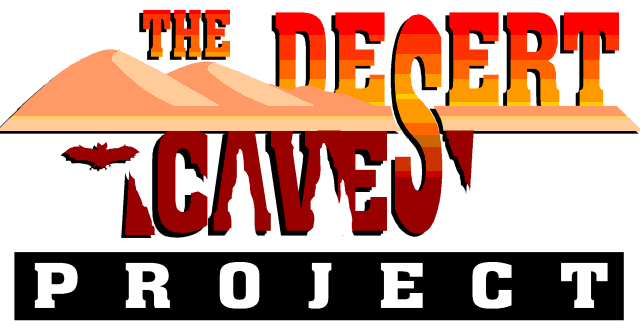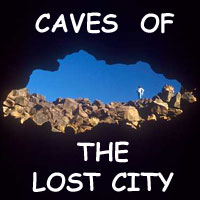THE
TOWN THAT WOULDN’T STAND STILL
AND OUR FIRST
LOOK AT LAVA TUBES IN HARRATS
KHAYBAR
AND ITHNAYN
© 2005 by
John and Susy Pint -- Updated September, 2013
Photos
by John and Susy Pint
It was an inauspicious
beginning. Our friend John Semple, had flown from Riyadh to Jeddah with
the plan
of buying a used Suzuki on Monday with the help of our mutual friend
Peter
Harrigan. The two of them would then drive with us the following
morning – in
that same car -- all the way to a remote town in northwestern Arabia
where large
caves had been sighted. Please note that in the paragraphs below we are
changing
the true name of this town to "Shisma" to avoid overwhelming it with
publicity (and incursions from the throngs of cavers who read these
reports). (2013: OK, I think it's now safe to reveal the
truth: Shisma is really the delightful town of SHUWAYMIS!)
It was a perfect
opportunity for Murphy’s Law to make an appearance and we were not
surprised
to get phone calls all through Tuesday notifying us of delay after
delay in the
agonizing process of buying a car. But by the end of the day, the deed
was done.
So it was that our
journey to Shisma began on Wednesday, November 6, 2002, which just
happened to
be the First of Ramadan, 1423. This meant everyone but us would be
sleeping in
extra late that morning, and we hardly saw any cars all the way to
Medina.
We proceeded northward
and when we finally rolled off the highway onto our first dirt road,
there were
still a few hours of daylight left.
A
wide track covered with powdery dust stretched before us. “This track
goes
straight to Shisma. We can’t miss it,” said our companions. “We should
get
there just in time for Iftar.”
Alhamdulillah, we
thought, because Susy and I were both dead tired. Iftar,
by the way, is
the meal that breaks the fast (which is very strict and allows no food,
drink or
even swallowing saliva all day long) and it begins exactly at sunset,
which is
announced by a cannon shot in many cities.
Well, we heard no
cannons and enjoyed no Iftar meal because, as the
sun slowly dipped below
the horizon, our wide track had utterly vanished and we found ourselves
in a
lovely but lonely plain dotted with acacia trees and surrounded by low
mountains.
“It seems like we
missed it after all,” announced our friends, who then mentioned that
they
didn't have the GPS coordinates for Shisma because it had been so easy
to find,
the first time they'd gone there.
So, Peter figured out
the coordinates from the topo map, put them into the GPS and we set out
to find Shisma in the dark, although I would have preferred to camp
right there in that beautiful spot and do our hunting in the daylight
the next morning...
Programming coordinates as the sun
begins to set. |
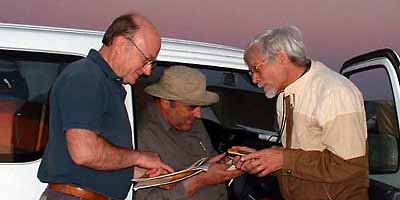 |
Well, bad luck
continued to plague us because when we reached the spot which coincided
with the
location of Shisma on the map, there were no bright lights anywhere to
be seen,
only utter darkness shrouding what looked like the remains of a ghost
town. But
we could see a dim glow in the far distance and we assumed that was
Shisma.
Off we drove through
billowing clouds of choking dust until we finally came upon a few
buildings and
several human beings. We asked if this was Shisma.
“Shisma?” It’s
twenty kilometers from here, thataway. Just follow the wide track – you
can’t
miss it.”
Ah, but we could miss
it and we did, once again finding ourselves on an ever narrowing track,
winding
through sharp-edged basalt rocks and growing fainter by the moment.
“Let me
try to reprogram the coordinates from the map again,” suggested Peter..
An hour later we were
back at the ghost town.
“What else can go
wrong on this trip?” shouted John and Peter. Now, I believe this
question was
meant to be rhetorical, but the answer came literally with a bang as
one of our
tires exploded.
Next we discovered that
the ruts underneath us were so deep that there was no way to set up the
jack
without wriggling into the space between the bottom of the car and the
sharp
rocks and choking dust. It was the sort of place even a caver would
hesitate to
crawl into and, once I had squeezed underneath, I was hardly overjoyed
to
discover that our official Toyota jack required the strength of
Hercules to
crank. Well, we took turns grunting, sweating and cursing until we were
at last
able to raise the car and change that poor, destroyed tire. It was
approaching
midnight when we finally limped to the least stony spot we could find
in the
neighborhood and tried to get some sleep.
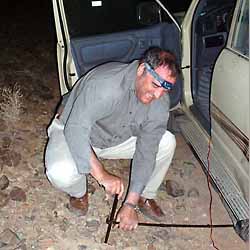 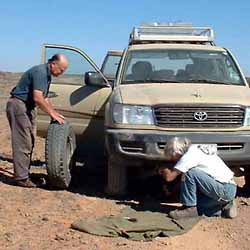
Here we present two flat tires for the
price of one. Notice how Peter's Petzl headlamp, shown on the left, can
be used for purposes other than caving, but not quite as much fun!
|
In the end, the
sumptuous Iftar meal we had dreamed of, came to
nothing but a miserable
bag of potato chips. Yes, but with a beginning like this, things could
only get
better!
In fact, a new day
dawned and we celebrated it with a truly luxurious breakfast which even
included
pancakes, whose batter Susy had prepared in advance.
Now that it was
light, we could see a town not far away and we assumed it must be
Shisma, but,
once we got there, we weren’t greatly surprised to find that it wasn’t.
“Well,
where is it?” we asked the two Bangladeshi mechanics who were busy
patching
the huge rip in our tire.
“Shisma? It’s about
twenty
kilometers from here. Just follow those power lines, you can’t…”
Well, we didn’t bother waiting to hear the rest of
the sentence and, of
course, the power lines soon went off in one direction while the track
went in
another.
But at this point, our
luck finally changed. We had flagged down an old man with a long white
beard,
who had told us we were still twenty kms from Shisma (This, of course,
was
hardly surprising to us, anymore) and who was giving us directions,
when Peter
and John happened to mention they were friends of the Headmaster of
Shisma.
The old man did a
double take, his eyes lit up and he reached out to shake our hands, as
if we
were meeting for the first time. “Hayakallah!” he said, which is a warm
greeting that bedus use amongst themselves. We had obviously moved up
to a much
higher category in his estimation and the greeting ceremony was being
repeated
in a proper bedu manner.
“I will take you to Shisma!” shouted the man as he jumped into his
truck,
even though he had been headed in the opposite direction.
At last, we broke the 20-km barrier and arrived within sight of the
Shisma water
tower, where the old man bid us Ma’asalaama. On arrival at the
Headmaster’s
house, we were greeted by his son Khalid who told us his father was out
in the
hills and was worried that we hadn’t shown up the night before. “I will
take
you there,” exclaimed Khalid, and off we went.
| Along the way, we came
to a vast, perfectly smooth area which glistened as if it were covered
with water. It was, however, a dry, tan-colored mud flat where nothing
grew and not even a stone could be found. “In this place a famous horse
race was once held,” said the Headmaster’s son,
“and that race resulted in a war that lasted
forty long years...” |
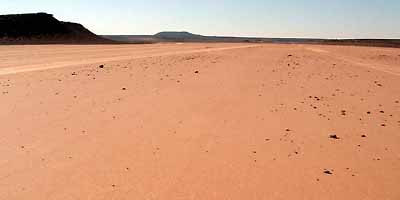 |
At last we came to a
wind-sculpted sandstone jebel where we finally met Headmaster Mamdouh
Al-Rashid,
who, from that moment on, took care of us as if we were his own
children.
Of course we told him all about the frustrating
attempts to locate Shisma.
“Ah, but Shisma is in the wrong place on all the maps,” explained the
Headmaster. “You see, we moved the town to a new location many, many
years
ago. The place your GPS kept leading you to is the old, abandoned site
of our
town.” At last, the mystery of the inescapable ghost town had been
resolved.
| ...And at last we got
to enjoy a Ramadan Iftar, which Headmaster Mamdouh,
realizing how tired we were, arranged to take place right in front of
the high sandstone jebel where we would camp for several nights...
|
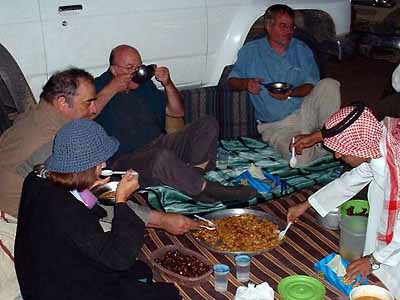 |
| ...The star of the
event turned out to be a beautiful falcon whose picture was taken at
least a hundred times that evening...
|
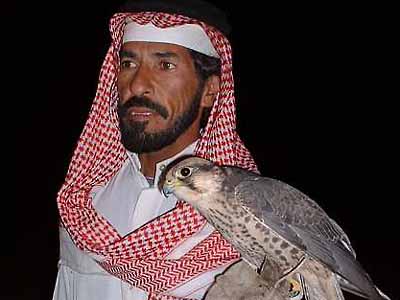 |
“I’m going to take
you out to a dahl,” announced Mamdouh the next day.
We learned that
people in this area use the word dahl for caves
which hold water and kahf
for the dry ones. The five of us piled into the
Mamdouh'’s car along
with his young son, because it was taken for granted our poor-quality
tires
would never survive the trip!
| On our way to the dahl,
we wound our way through sprawling fields of volcanic rubble. Then we
spied a small lagoon, a sight you rarely see in Saudi Arabia, proof
that more rain falls here than in other areas we know...
|
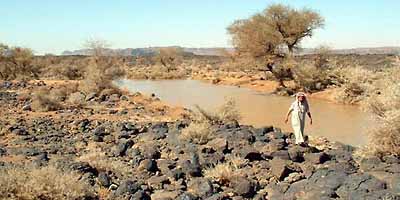 |
...I remembered that
people had warned me about lakes in certain harrats. “There is a large,
black
water snake that is extremely vicious and capable of jumping out of the
water
and attacking people standing by the shore,” I had been told.
Fortunately,
the Headmaster assured us there were no such jumping serpents in his
area and
after a pleasant stroll around the lagoon, we drove on, past a
mountain, over
1600 meters high, until we were well inside of Harrat Khaybar, where
Saudi
Arabia's most picturesque volcanoes are located.
| Soon we arrived at the
entrance to Dahl Rumahah, which you would never find if you weren’t
looking for it. But what you do see is a long, low, curving wall built
of rocks. ...
This is just a
small section of the wall.
|
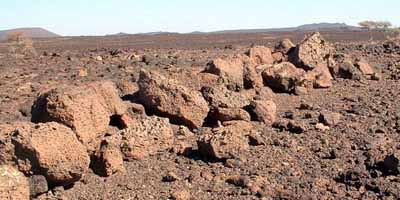 |
“This wall channels
runoff rainwater into the dahl,” explained our guide. “Once upon a time
this
cave was kept secret and its entrance hidden because it was a valuable
source of
water, a reservoir actually.”
| Headmaster Mamdouh at
the long, low entrance to the dahl ...
...and ready
to defend us against the wolves commonly found in caves like this one.
|
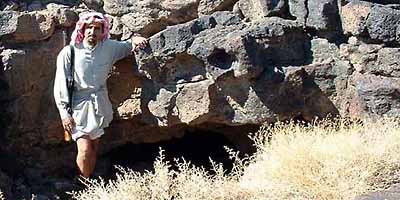 |
Mamdouh was
amazed we planned to go inside with our dinky little headlamps and
flashlights.
“Now, this is the kind of light you need for a cave,” he announced,
holding
up a gas lantern, which, indeed, gave off plenty of light, but was a
bit too
fragile as far as Susy and I were concerned.
As soon as we went
inside, we assured the Headmaster that his dahl is indeed a lava tube
(a point
that had been disputed). The ceiling had the classic arch and a few
small levees
here and there. Surprisingly, the cave meandered in several directions
and had a
couple of side passages.
| In places, the ceiling
and walls were draped with impressive flowstone...
This is
probably calcite from leakage through ceiling cracks. As you can see,
in all these pictures we had as a model, Mamdouh's son Ahmed, who
seemed to have a natural talent for the job.
|
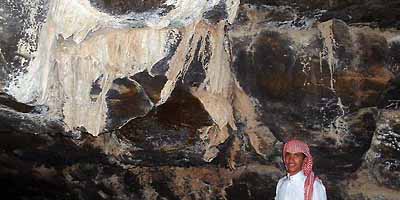 |
| Bones and the petrified
scat of hyenas and wolves covered the floor in some areas. ...
Click on the
picture to see how extensive this cache of bones is. Fortunately, we
didn't meet any of the creatures who had been munching on those bones.
|
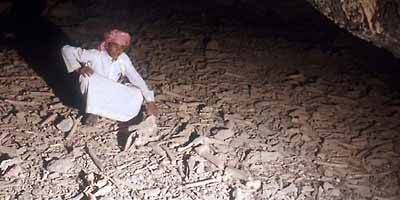 |
| We also found two
“natural bridges” in this cave...
Here Ahmed
shows us the thin bridge, where you can see an intact section of the
crust that sometimes forms on top of the hot river of lava inside the
tube.
|
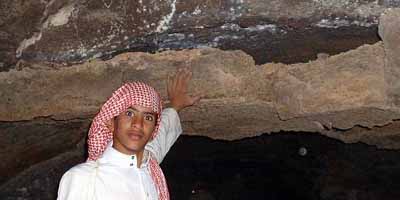 |
| This second bridge is
remarkable for its thickness, since the levees we've seen all point to
a crust similar to the Thin Bridge above. So why did the lava continue
to flow beneath this Fat Bridge, which must have taken quite a while to
cool?
Dahl
Rumahah may hold the answers to more than one question about
the mechanics of flowing lava.
|
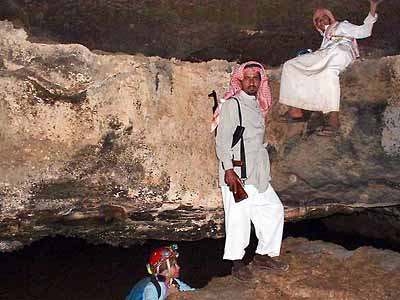 |
In one area, we
came upon small pools of water and marks on the walls indicating that
once upon
a time the water level had been waist high...
| ...The humidity in this
part of the cave has left areas of the wall covered with tiny drops of
water which look like a coating of white paint from a distance ...
These drops
may be growing on a layer of "cave slime," as seen in Iceland. The
bacterial content of the slime may be very interesting.
|
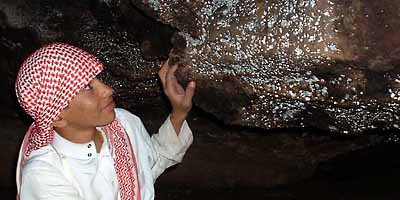 |
Back in the 1980’s
Headmaster Mamdouh had measured this cave with a 50-meter long tape,
probably
making him the first person to survey a lava tube in Saudi Arabia. He
recalled
the cave as being about 500 meters long, but, unfortunately, had not
drawn up a
map of it.
We returned to our
campsite near sunset and fried our hamburgers even though we’d be
having
another Iftar just a few hundred meters down the valley. We didn’t want
the
meat to go to waste, and it didn’t. Each of us ate a hamburger and then
we
left three more of them in the frying pan, which I deliberately placed
on the
ground. As we walked toward our friends’ camp, we found their saluqi
dog along
the way, staring at our cooking area with rapt attention. “I don’t
think
those hamburgers will last long,” I told Susy, and sure enough, when we
got
back we found the frying pan licked clean. Later, however, we were told
that
this particular saluqi would never do such a thing. So we figured it
must have
been..
THE
MOUSE
What mouse?
Well, later that evening, as we sat in the dark
listening to the BBC news
on our WorldSpace satellite radio, Peter shouted
“Hey! Some animal keeps bumping into me!” I switched
on my light and
there was a cute little mouselike creature, tan and white in color with
big eyes
and a long tail. It reminded me more of a gerboa (without the powerful
back
legs) than your average mouse. Anyhow, it moved away very slowly, as if
reluctant to be interrupted while scrounging for crumbs at Peter’s feet.
The next morning,
while we were brewing our gourmet Camp Coffee, John
asked Peter a curious
question: “You weren’t eating potato chips somewhere near my cot last
night,
were you?” He had woken up and found chip crumbs everywhere inside his
sleeping bag. “It wasn’t me,” replied Peter, “but I think I know who it
was. That mouse was rattling the potato chip bag all night long and I
bet I know
exactly where he went to eat them: a nice, warm, snug place next to
you, the
world’s heaviest sleeper.”
Peter
went on to tell us how John had once slept through the Thunderstorm of
the
Century which had sent everyone but him out of their tents and into
their cars
for safety.
Over breakfast we also
heard a number of stories about four-wheel-drive Suzukis, such as the
one John
had just purchased and which had not given us the slightest problem on
this
trip. “I came upon a chap in Africa who was preparing his Land Rover
for a
trip across the Kalahari. He spoke like one who knew everything from A
to Z
about safaris and at a certain point he turned to me and cast a
disparaging eye
upon my fully loaded Suzuki.
‘Shame on you for
endangering human lives by trying to take a toy like that across the
Kalahari.
If you don’t have a Land Rover you shouldn’t even consider such a trip.’
‘Actually, I’m not
considering it because I have just come from there. In fact, I crossed
the
Kalahari in this very Suzuki and on the way I passed at least three
Land Rovers
like yours, stuck in the mud and unable to move.’ ”
| The next day we drove
off to Hazm Khadra, a scoria cone located in Harrat Ithnayn. Like Jebel
Hil, this volcano has a series of holes leading away from it, marking
the path of a lava tube....
The biggest of
these collapses stands out like a sore thumb, but is filled with dirt.
|
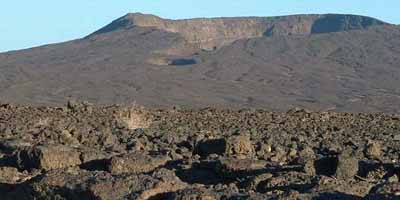 |
Unlike Jebel
Hil,
you don’t have to hike for twelve kms over nasty Aa lava to get there.
In
fact, we drove straight to the most interesting-looking collapse and
camped next
to it. It was our first look at a lava tube in this area.
| The entrance hole was a
long slope piled with huge chunks of basalt and reminded me of the
entrances to some of Iceland’s
biggest caves.....
Susy Pint at
the top of the slope.
|
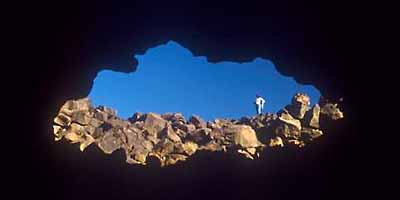 |
...As soon as
we
stepped into the first room of the cave, we suspected this was going to
be the
biggest lava tube we had ever entered in Saudi Arabia. The first room
was really
high and ledges could be seen far above us, perhaps the remains of
enormous
levees.
| There was no time for
surveying, but I paced off 700 “big steps” from end to end and we found
several other rooms impressively high and wide, including one with a
nice round dome ceiling. As for stalactites and stalagmites, there
wasn’t much to see, nor were there any signs of the gypsum formations
we had seen in other lava tubes. There were plenty of bones, however
and in the evening we saw a few bats exit the cave..
"Cave Ghosts"
painting the wall of the dome room with light.
|
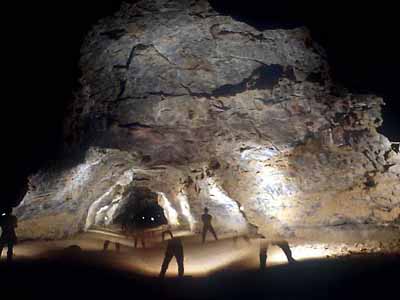 |
Walking along the
surface toward the scoria cone, we found some holes filled with dirt
and others
with short pitches promising passages below. We also saw “kites” or
stonewall corrals with one very long wall extending off for a great
distance.
Supposedly, people drove animals to the wall, which they would follow
until they
found themselves trapped in the corral. As if to corraborate
this theory,
Peter found fragments of ostrich eggshells lying on the ground. Is this
what
those ancient hunters were after?
As
we headed
back towards Shisma, we got another flat tire. This was easier to
change now
that we were experts in the business, but we didn’t feel too great
about
putting on a spare with an inner tube inside and a huge gash outside.
We then
said goodbye to Headmaster Mamdouh and drove off towards the highway in
the
usual clouds of dust. In the first town we came to, we discovered that
our luck
had truly turned. We found brand new Bridgestone tires for sale,
exactly our
size. Peter and John assured us these were far better than our Dunlops,
so we
bought them and began the long journey back home, quite delighted to
have
visited two different Harrats in one trip and to have found remarkable
caves in
each of them.
John
Pint
|








